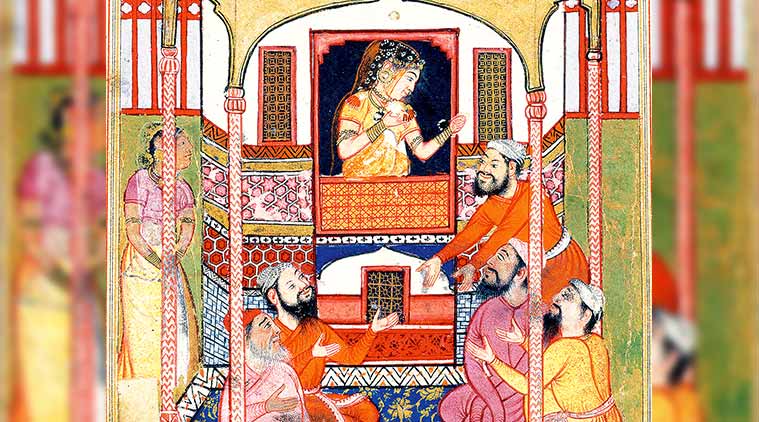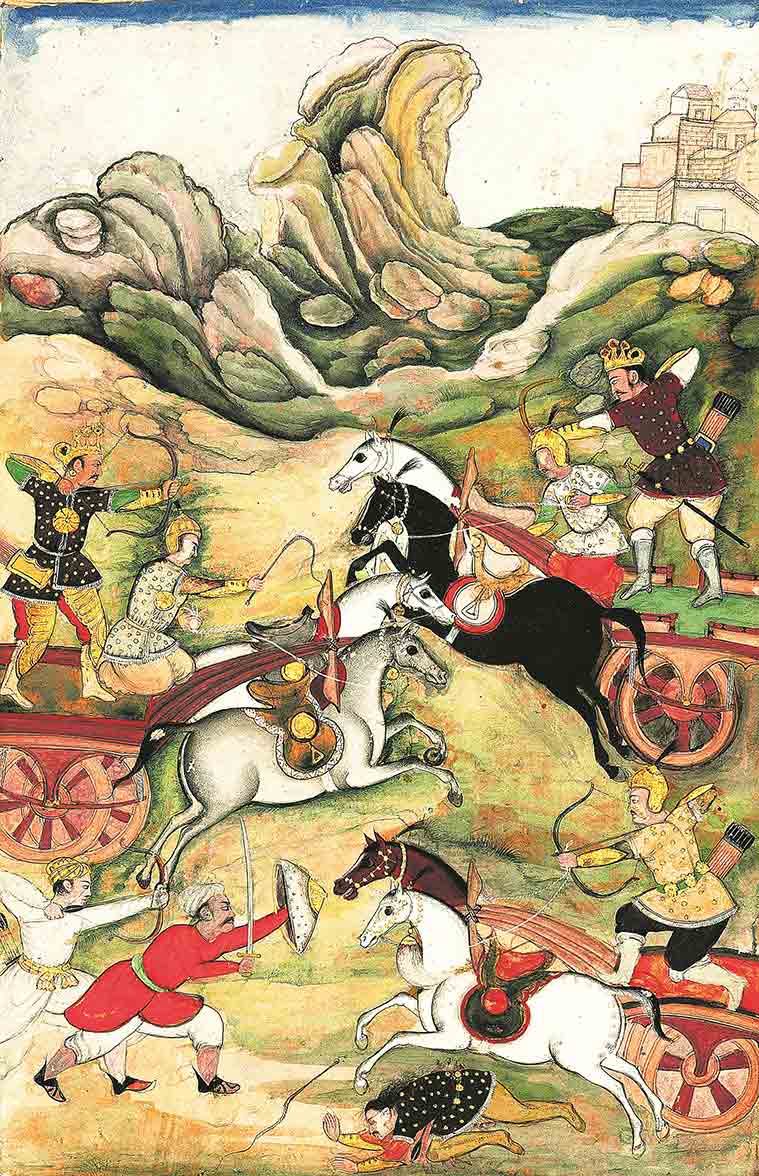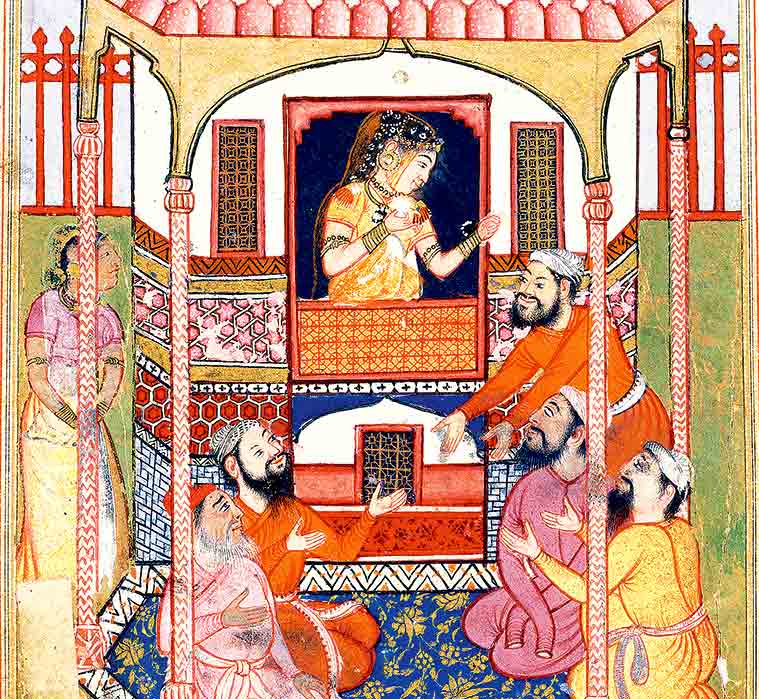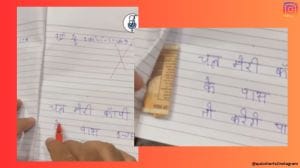- India
- International
Amid the BHU professor appointment row, a look at Muslim scholars of Sanskrit in history
Past perfect, present tense: The recent protests against the appointment of a Muslim professor in Sanskrit Vidya Dharma Vigyan department at BHU, therefore, seem to be the new way of the admirers of Manusmriti, the Vedic text which denigrates lower classes, to wallop the “other”.
 Text and subtext: (From top) A folio from Razmnama, the Persian translation of Ramayan carried out during Mughal emperor Akbar’s regime. (Photos: Wikimedia Commons)
Text and subtext: (From top) A folio from Razmnama, the Persian translation of Ramayan carried out during Mughal emperor Akbar’s regime. (Photos: Wikimedia Commons)
Is Sanskrit an alien language for the Muslims? Not quite, if one rummages through the history of the subcontinent. It is hard to find any period after the advent of the Muslims without reference to Muslim scholars of Sanskrit. The recent protests against the appointment of a Muslim professor in Sanskrit Vidya Dharma Vigyan department at Banaras Hindu University (BHU), therefore, seem to be the new way of the admirers of Manusmriti, the Vedic text which denigrates lower classes, to wallop the “other”.
To begin with, the animal fables of Panchatantra, based on ancient oral traditions, were converted into Sanskrit text dated roughly to 250 BC. It was translated into Arabic in the eighth century as Kalilah wa Dimnah by Abdullah Ibn al-Muqaffa. The original Sanskrit text of Panchatantra perished and it was translated into Indian languages from Arabic.
Firdausi, a 10th-century Persian poet of Iran, tells the story of the Persian translation of Panchatantra in the epic Shahnama. According to Shahnama, the translator Borzuy, a physician who had visited India in search of a herbal medicine, had heard that the herb he was looking for would return a cadaver to life when it is sprinkled over it. Most probably Firdausi had some knowledge of Sanjeevani herb fetched by Hanuman, as mentioned in Ramayana, which he touched upon in his epic.
 A miniature painting from Tutinama (Tales of a Parrot) translated into Persian by Zia Nakhshabi. (Photos: Wikimedia Commons)
A miniature painting from Tutinama (Tales of a Parrot) translated into Persian by Zia Nakhshabi. (Photos: Wikimedia Commons)
Al-Biruni (973-1050 AD), one of the great literary figures of the medieval Islamic era, is counted among the early Muslim Sanskrit scholars. His encyclopaedic work on India, Tahqeeq ma li-l-hind min maqulah (Verifying All That the Indians Recount) explores every aspect of Indian life, including culture, religion and philosophy. Al-Biruni was an erudite scholar of Sanskrit and a linguist who wrote over a hundred books, some of them on Samkhya, a philosophical system, and Yoga.
The first Sanskrit book which is believed to have been translated into Persian was Suka-Saptati (Tales of a Parrot) as Tutinama, circa 12th century compilation of amusing ancient narratives, told by a wise parrot to a lonely, sad woman separated from her husband to save her from straying. Tutinama got unprecedented popularity and was translated into many European languages. In addition to Tutinama, Zia Nakhshabi, a Persian physician and Sufi living in India, translated Kok Shastra or Rati-Rahasyam (Secrets of Sex) into Persian.

 Most probably Firdausi had some knowledge of Sanjeevani herb fetched by Hanuman, as mentioned in Ramayana, which he touched upon in his epic.
Most probably Firdausi had some knowledge of Sanjeevani herb fetched by Hanuman, as mentioned in Ramayana, which he touched upon in his epic.
Sufi poet and scholar Amir Khusro (1253-1325) had a great knowledge of Vedas and Puranas. Unfortunately, none of his Sanskrit books lasted, but he used numerous Sanskrit words in his prose and poetry. Khusro focused on the documentation of languages, with separate mention of Sanskrit, in his masnavi (extensive poem) titled Nuh-Siphar (Nine Skies). He also wrote a Persian couplet about the language: “Sanskrit naamazahd-e-kuhanash-aammanadar adkhabaraz kun makanash (Sankrit is a Brahmin, belongs to ancient era and common people don’t know it”).
Muhammad bin Tughlaq (1290-1351) is referred as a wise fool in history due to his failed expeditions. Two Sanskrit inscriptions of his era confirm his generosity towards every culture. British historian Stanley Lane-Poole considered him “a man of knowledge and keen student of Sanskrit poetry who colonised in Avadh a particular settlement for Sanskrit poets called Swarg Dwar (The Doors to Heaven)”.
Among the later sultans of the Delhi Sultanate, Firoz Shah Tughlaq (1309-1388) was the first who felt the necessity to translate several ancient Sanskrit texts into Persian, writes historian Abraham Eraly in The Age of Wrath (2014). Zain-ul-Abidin, a 15th century ruler of Kashmir, appointed some professional scribes to translate Mahabharata and Kalhana’s Rajatarangini, written in the 12th century, into Persian. He believed these translations would give an insight into the Indian philosophy and culture to the rest of the world.
Mughal emperor Akbar’s period may be called the golden era of Sanskrit literature. During this period, the Muslims started to take greater interest in Sanskrit literature and Hindu religion. Akbar (1542-1605) ordered Mulla Abdul Qadir Badayuni to translate Singhasan Battisi (Thirty-Two Tales of the Throne), Atharvaveda and Ramayana. Badayuni translated the Ramayana and the Singhasan Battisi (Khirad-Afza, Wisdom-Enhancing Book) but could not complete the translation of Atharvaveda. Almost all courtiers and chroniclers of Akbar, including Faizi, Abul Fazal, Todar Mal, Badayuni and Raskhan, were well-versed in Sanskrit. Faizi translated Nal-Damyanti as Masanabi Nalaudaman and wrote the preface of Mahabharata which was a collective translation of many scribes.
It was Akbar who paved the way for Dara Shikoh (1615-1669), admittedly the greatest scholar of the Mughal dynasty. He devoted himself to the comparative studies of religion. He also translated the Bhagavad Gita into Persian. Swami Nand Das and Baanwali Das translated Prabodh Chandrodaya (The Moon of Intellect) and Yoga Vasishtha for him.
Dara Shikoh’s Samudra Sangama (The Confluence of Oceans), is the most important text for the comparison of Sufism with Indian doctrines and spiritual practices, writes French historian Jean Filliozat. Dara’s greatest literary achievement was the translation of 52 Upanishads from Sanskrit into Persian, titled Sirr-i-Akbar (The Great Secret) and, in some manuscripts, Sirr-ul-asrar (The Secret of Secrets).
Emperor Shah Jahan (1592-1666), Dara Shikoh’s father, had employed two Sanskrit poets — Bansidhar Mishra and Hari Narayana. They translated many ancient Sanskrit texts into Persian. Maneshwar and Bhagwati Sawaman wrote two books on astronomy and prosody, respectively, under his patronage. After Dara Shikoh, only one reference to Sanskrit is found: when Azam, son of Aurangzeb, sent a gift of mangoes to his father, he wrote the Sanskrit names of mangoes as “rasavalas” and “sadharas”.
Urdu poet Allama Iqbal was also a scholar of Sanskrit and a staunch follower of Adi Shankaracharya. He translated some shlokas of Bharthari, the 5th century AD Sanskrit writer who wrote Vakyapadiya on Sanskrit grammar and linguistic philosophy, and Satakatraya, a volume of poetry. In Javed Nama (Book of Eternity, 1932), he introduced Brahmarshi Vishvamitra, many Sanskrit poets, and Rumi. Iqbal also translated Gayatri Mantra. A note from the translator was also published with the translation of Gaytri Mantra, mentioning particularly one of its words, tat savitur. Iqbal wrote that it was an untranslatable world and he merely tried to reach its closest meaning by translating it as “perpetual luminescence”.
Muslims have not stopped learning Sanskrit even now. Israil Khan, who received the President’s award for his knowledge of the Vedas in 1993, has written several books on Sanskrit, including Yaskiye Nirukti Vivechan (The Etymologies Of Yaska 1985) and Themes of Atharvaveda (2001). Mohammed Hanif Khan Shastri got the Padma Shri award in 2009 for his contribution to Sanskrit. Maaruf-ur-Rahman, a young scholar, has written Bhartiya Sanskriti Mein Manovigyan (Psychology in Indian Culture, 2016). Hasnain Nazmi is a contemporary poet of Sanskrit. Rajesh Sarkar, professor in BHU Sanskrit department, reveals in an article that several works of Islamic literature were written in Sanskrit. Today, hundreds of Sanskrit scholars are engaged in academic activities all over India. In the charged and changed political scenario, one wonders whether they will be allowed to continue.
Apr 16: Latest News
- 01
- 02
- 03
- 04
- 05






































